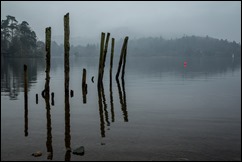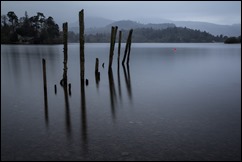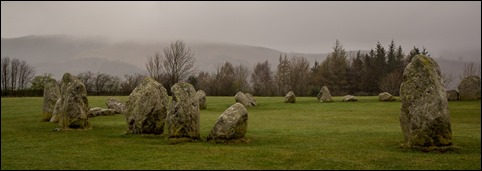We had a few hours of dry but cloudy weather before the late morning/afternoon rain began. Francine wanted to go back to part of Derwent Water to “correct” one of her initial shots. Landscape photographers, being fond of a bit of foreground interest, are drawn to partially submerged boulders, wooden piers/jetties, or wooden posts remaining from piers/jetties long since gone, reeds, and the like. Indeed, one of our better known landscape photographers, Joe Cornish, has led to boulders in water being referred to as JCBs [Joe Cornish Boulders] – by other photographers, of course. How’s that for fame? Francine had tried a couple of these but her wooden posts (remaining from piers/jetties long since gone) had some boulders interfering them. When in doubt, adjust your line up and simplify.
Better! The second is another example of Francine’s Big Stopper, hence the smoothed water. [For those wondering, the Lee Big Stopper is a 10-stop neutral density filter which turns, say, a 1/125th second exposure into an 8 second exposure.]
The day was deteriorating fast so we used the time for an exploratory drive. We headed off down Borrowdale, headed up a 1 in 4 (25%) ascent to cross over Honister Pass with its slate mine, thence down to Buttermere and Crummock Water, before wending our way back over Whinlatter Pass to Bassenthwaite Lake. Completing our circuit, we called in to a photographers’ attraction just outside Keswick: the 4500-year-old Castlerigg Stone Circle. Despite the pants conditions with the wind driving moisture at us, Francine once again extracted her camera, back to the wind, for a test shot, albeit a line-up enforced by the weather conditions.
In La Belle France, to be precise, in the Marais Poitevin, a drained marsh area criss-crossed by drainage canals, I have previously made mention of the French having no fewer than five words for canal, depending upon its size. This seemed a bit like overkill at the time. However, from our brief drive past a few of the larger bodies of water here, we appear to be doing very nearly as well in the Lake District with said larger bodies of water being variously tagged water (e.g. Derwent Water), lake (e.g. Bassenthwaite Lake) or mere (e.g. Buttermere). Smaller water bodies tend to be tarns.
Isn’t richness of language wonderful? What a pity that modern trends tend to be simplifying too much of it.




Leave a Reply